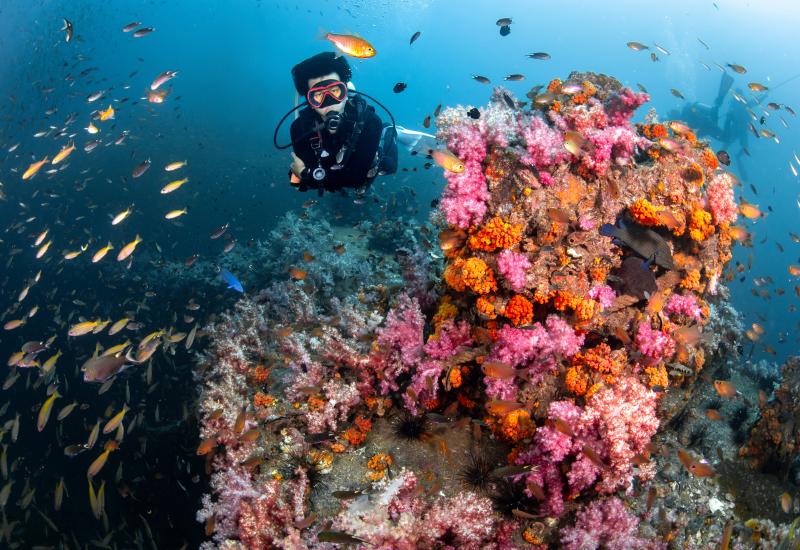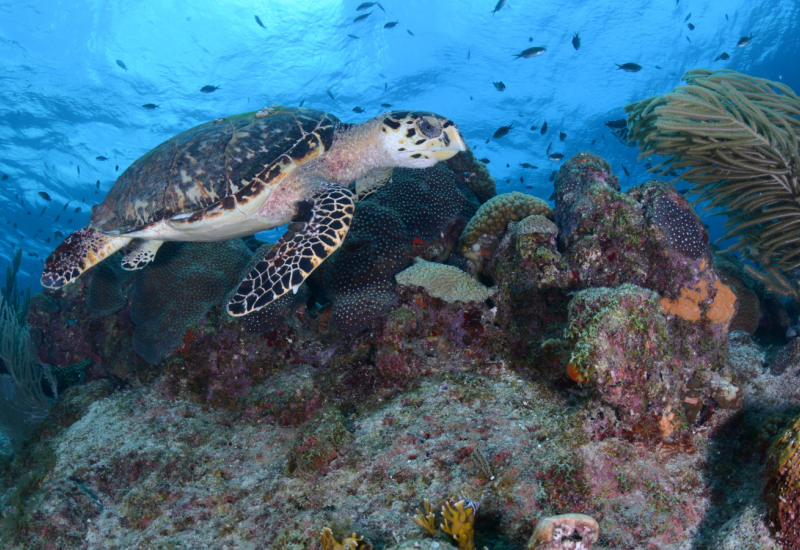7 Best Dive Sites in Bocas Del Toro, Panama

Shutterstock.com/Basilio RushAerial image of a beach in Bocas del Toro, Panama.
A destination filled with exotic marine life, rich Afro-Panamanian history and delicious local seafood… Sounds good? The Panamanian archipelago of Bocas del Toro awaits, where adventure seekers can experience monkey- and sloth-filled walks around white sand beaches, island hop by water taxi to snorkel among thick mangroves, hike in the Red Frog rainforest, and take a local dugout canoe ride at the village of Quebrada de Sal.
Perhaps the most thrilling of all activities is scuba diving around the archipelago, home to more than 90% of all available coral species in the Caribbean Sea. Bocas del Toro has a huge variety of marine life to discover, from tiny seahorses and nudibranchs to impressively sized whiptail rays and nurse sharks. I spoke to locals Kelly Paterson and Leandro Mora from the Bocas Dive Center to get the inside tip on their seven favorite dive sites.
Related Reading: Is This The World's Wildest Nudibranch?
1. Dolphin Rock
Pinnacle lovers will enjoy exploring Dolphin Rock, where you can see the tip of the rock formation sticking out of the water during low tide. “The lava rock boasts a huge amount of animal life, especially schooling fish and juveniles, and there are large sand channels that radiate out from the rock, often home to sleepy nurse sharks,” says Paterson. “This site offers great macro life, but can be a challenging dive due to swell and surge, therefore it can only be accessed at certain times of the year.”
The maximum depth is 65 feet (20 meters).

Courtesy Leandro MoraBuoyline, a popular dive site in Bocas del Toro, is a great site for seeing marine life big and small.
2. Buoyline
Buoyline hosts a wonderful range of topographies, from sand and sponge gardens to hard and soft coral, and even a trimaran wreck. “There is a wide range of life to see here, from stingrays feeding in the sand, porcupine puffers hiding in massive brain corals, moray eels, and scorpionfish in the shallows,” explains Mora. “Occasionally this site has a light current, but nothing a diver can’t swim against and drift back to the boat, making it ideal for beginners and experts alike.”
The maximum depth is 60 feet (18 meters).
3. Tiger Rock
Despite being over an hour away from most of the local dive sites, it is a favorite of the staff at Bocas Dive Center because it’s an open-sea site. “These massive pinnacles drop down to more than 40m, and the huge open ocean waves can make this dive site challenging for even the most experienced divers,” advises Paterson. “We only venture there when the conditions and divers are suitable. However, the site never fails to please — from nurse and other sharks, to nudibranchs and huge schools of pelagic fish, this dive site has it all.”
The maximum depth is over 130 feet (40 meters).

Courtesy Leandro MoraView from brain coral at Grandma's Garden.
4. Grandma’s Garden
The huge coral bommies found in the warm, clear, shallow waters at the start and end of the dive make this a favorite for local divers. Paterson and Mora describe the site as being a place to swim through huge schools of grunts and snappers, as well as to check out the cracks in the corals for the stunningly beautiful juvenile yellowtail damselfish. “The main reef also offers chances to find various species of toadfish, shrimps and often trunkfish,” says Mora.
The maximum depth is 45 feet (14 meters).
Related Reading: Where to Go Scuba Diving in South Carolina

Courtesy Leandro MoraCoral "bommies" or patch reefs found at the dive site Airport Point.
5. Airport Point
This beautiful site starts in the sandy shallows which are abundant with various urchins, including sand dollars, inflated sea biscuits and long spine porcupinefish. “The coral bommies open out onto the fringing reef where mahogany snappers, sergeant majors and hamlets are abundant,” says Paterson. “Keep your eyes up as there are often spotted eagle rays here.”
The maximum depth is 60 feet (18 meters).
6. Barco Hundido
The dive site starts in a shallow sea meadow where there are a number of different green algae species that attract not just juvenile fish, but pipefish and grass squid. The sand that meets the meadow is often home to upside-down jellyfish, pincushion sea stars and various conchs and snails, making it a favorite dining location for huge whiptail rays. “The highlight of this site is the old ferry which is covered in beautiful sponges and corals and home to a massive range of crabs, including sponge decorator, hermit and yellow arrowline,” says Mora. “There are also a few seahorses that like to call this area home.”
The maximum depth is 52 feet (16 meters).
Related Reading: New Species of Deep-Sea Crown Jelly Discovered in Monterey Bay
7. Mayday
If you’re a fan of seahorses, lobster, crabs, eels or octopus, Mayday is the site for you. “This is our exclusive dive site, right off the dock here at the Bocas Dive Center, so named because it features a sunken airplane and sailboat, but also a heart coral sculpture and coral reef,” says Paterson. “Despite its location in town, this dive site often has various species of rays, including mobula, cownose, eagle and stingrays. We use this site for our beginners, but even the most advanced divers will find something special here, especially at night.”
The maximum depth is 52 feet (16 meters).
Related Reading: How Intelligent Are Octopuses? Your Octopus Questions, Answered.

Courtesy Leandro MoraDon't forget to look closely, you might find some fascinating critters like this nudibranch!
Where to Stay:
Isla Bastimentos is one of nine islands that belong to the Bocas del Toro Archipelago, and divers can book oceanfront bungalows at The Firefly. Constructed from plantation-grown hardwoods, fallen trees and reclaimed lumber, amenities include an on-site pool, a rainwater catchment system to provide water, compostable straws, and complimentary bottles of bug spray in your room made from essential oils. Ask for snorkeling gear, stand up paddle boards or get some post-dive zen time in the yoga space. The property is a 10-minute water taxi ride from town and the Bocas Dive Center.










